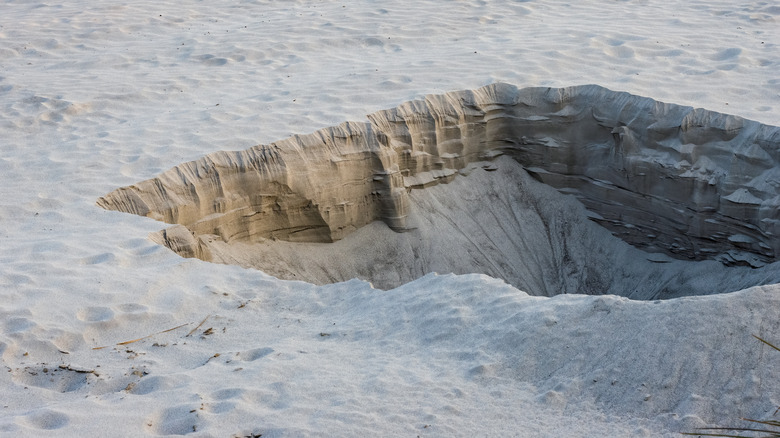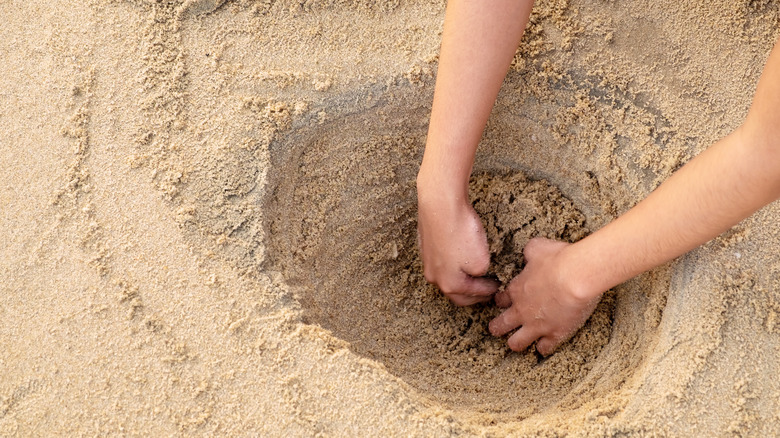The Deadly Reason To Think Twice Before Digging Holes In The Sand While At The Beach
No matter your age, a beach day is all about having fun in the sun. This could mean taking a dip in the ocean or learning how to build a sand castle. Another typical seaside pastime is digging a hole in the sand. Even if you haven't done this, chances are you've witnessed fellow beachgoers hard at work with shovels and buckets. However, this seemingly benign activity can result in tragedy. The sand can cave in and ultimately trap and kill diggers. Unfortunately, this has been the case at various beach vacation destinations in the U.S. in recent years.
In May 2022, an 18-year-old in New Jersey died when the hole he was digging in the sand gave way. His younger sister was also involved but survived. The same thing happened to a 17-year-old vacationing in North Carolina a year later. He was removed from the collapsed hole but did not live. In February 2024, 7-year-old Sloan Mattingly and her brother were visiting Lauderdale-by-the-Sea, Florida, when the hole they dug on the beach collapsed.
Although her brother survived, Sloan did not. Her parents witnessed the incident, and in an interview with Good Morning America, Sloan's mother, Therese Mattingly, stated, "It didn't matter that we were literally right there." She added, "It was just a hole, and then there's nothing. And then it just becomes chaos and horror." In short, sand is destructive, and digging a hole in this powdery material should not be taken lightly.
Sand holes are fragile and fatal
To understand why sand hole collapses kill, first, you must know what causes the sand to give way in the first place. Speaking with NBC6, Dr. Stephen Leatherman, a professor from Florida International University's Department of Earth and Environment, said that it all comes down to depth. "When people dig holes more than two feet deep and get in them, at least where their body's below the sand level, sand starts drying out immediately." He continued, "And dry sand can only hold a 33-degree angle, and people dig these holes almost vertically."
The sand is fragile, and this, in turn, causes the hole to crumble in an instant. That said, individuals trapped by sand can die from suffocation. Sand, wet or dry, is incredibly heavy, and one cubic foot can easily weigh more than 100 pounds. This makes it nearly impossible to breathe or move.
Keep in mind that without oxygen, individuals can die within less than 10 minutes. Pediatric trauma surgeon Christopher Moir also noted (via Slate), "If you can breathe, you're breathing in the sand." This can obstruct the respiratory system and be fatal. Furthermore, rescuing individuals from sand holes is tricky. The hole could continue to give in, hindering efforts. As mentioned, time is of the essence. The longer someone is trapped in the sand, the more likely they won't survive.
Protect yourself and others while digging sand holes with these tips
Sand holes are dangerous not only to the individuals digging them. Someone enjoying their beach day could accidentally fall in and hurt themselves. In addition, sea turtles can also be entrapped by sand holes. Given all of this information, it might not be surprising to learn that some destinations have implemented digging rules. For example, in Bethany Beach, Delaware, a hole cannot be over one foot deep, and in Horry County, South Carolina, home to Myrtle Beach, it cannot be over two feet deep.
With that in mind, if you or your kids decide to participate in this activity, Dr. Stephen Leatherman told NBC6, "If you dig holes — no deeper than two feet, and cover them up when you leave. Keep it shallow and you don't have a problem of collapse." Moreover, ensure the beach you visit has a lifeguard on duty, which is essential for beach safety. Some lifeguards may even be trained to rescue beachgoers from these incidents.
However, don't be surprised if a lifeguard tells you to stop digging if they notice your sand hole is getting too deep. Likewise, if you happen to stumble upon a sand hole at the beach, fill it up to ensure no one falls in or worse. If you're interested in learning more about beach safety, check out what it really means when you see a red flag at the beach.


